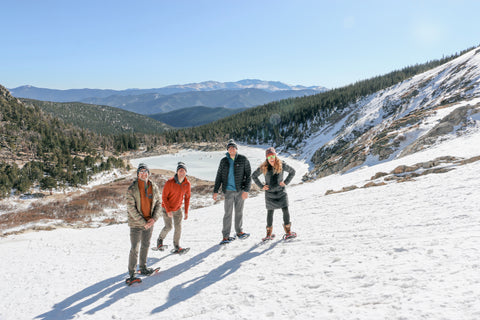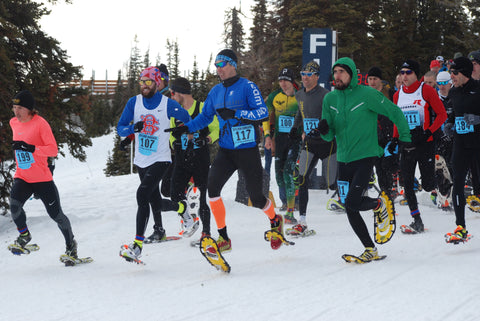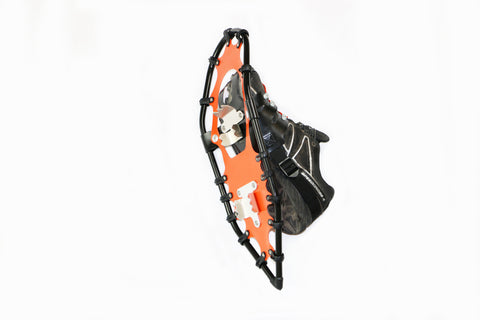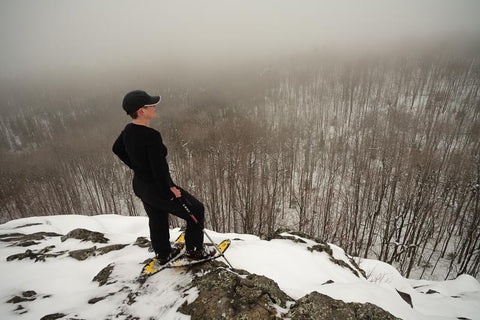As temperatures start to cool, thoughts turn to the coming winter and with that, winter sports. One winter sport that Is quickly becoming popular is snowshoeing.
Running Snowshoes & Their Benefits
Short days and long winter nights mean hibernation mode has arrived for many of us. But the start of our grey season does not mean you have to turn into a sloth and put your metabolism to sleep until spring. Not sure what to do this winter? Here is a great activity that you should book into your fitness plan this year: Snowshoeing.
Snowshoeing has become a popular pastime in many other states that embrace winter sports. The wonderful thing about snowshoeing is you don't need any specialized skills or training to do it. Any person that can hike can snowshoe.
Snowshoes allow you to make the most of many outdoor winter activities whether that means navigating your way in the mountains, hiking on your favorite trails, or simply exchanging your running shoes for running snowshoes.
That said, snowshoeing is as effortless as putting one foot in front of the other – and selecting the best running snowshoes can be uncomplicated once you know what to search for.
What is Snowshoe Running?
Snowshoeing is a form of flotation of sorts since you stay pretty much on top of the snow. But it does take a little adjustment in walking style.
You have to slightly lift the shoe while sliding along the inner edges over each other to avoid exhausting the legs. Turning around can be tricky at first.
But, many runners have found the best way is to make a small circle instead of lifting one foot and turning it completely in the opposite direction followed by the other foot which much like the method used when wearing skis.

If you are a runner, snowshoeing offers a great way to continue running in winter. This sport can be extremely beneficial in increasing your running endurance and strength overall while covering distance and enjoying the outdoors.
Some ski areas even offer snowshoe races and usually, you can find a local park to snowshoe with if or when you are unfamiliar with the area.
What Are Running Snowshoes?
Running snowshoes, however, are very different from the hiking and backpacking kind. They are lightweight, first and foremost, to make your feet as light as possible.
They are also typically quite small, with a few cleats. Finally, running snowshoes also have a tight suspension system of some kind, so that they don't flop around too much and get in the way while running in the snow.

This sport can be a serious and rigorous exercise, up there with running a marathon, with many ultra marathons now taking place in the winter over proper and groomed trails.
But conversely, it can be a leisurely day in the woods too. In any case, you will see and experience beautiful areas and scenes and get some exercise even in the snow.
Running snowshoes are:
- Perfect for runners who want to strength-train by running in the snow.
- These shoes are created asymmetrically with a smaller footprint to keep you from kicking yourself as you run.
- Great for packed trails anywhere there’s snow.
There is that unmistakable sense of freedom once you put on your snowshoes and head out across the countryside and a renewed pleasure in the beauty and solitude of the forest.
You too can experience the same sort of adventure the next time you are in a snowy area by trying snowshoeing. It is immensely fun, something all ages can do, and a simplistic healthy way to enjoy the outdoors.
What Are The Differences Between Running & Trail Snowshoes?
While snowshoeing has been around for many years only recently, since the 1970's, has it become a recreational activity for outdoor enthusiasts.
Snowshoeing was a necessity for many living in rugged, snowy terrain and the only way to travel through deep snow during the winter months.
Along with the recent popularity of snowshoeing, technology has stepped up and designed and manufactured more durable and lightweight snowshoes.
Snowshoes have come a long way since the wooden framed, rawhide-laced versions worn by Inuits and Native Americans.
Running snowshoes appear similar to the other models and there are subtle differences that you need to be aware of. Keep in mind that not all snowshoe models are designed for a single purpose.

So, if you have just started getting into snowshoeing and have been wanting to run in the snow, here are some differences between running and trail snowshoes:
Unlike various sizes of backcountry or mountaineering snowshoes that support your weight and varying snow conditions, generally, running snowshoes look almost the same.
In order to run, small snowshoes are much more important than body type.
Choose a pair of small and light small snowshoes that fully supports normal running gait and speed.
This is also true with the type of snow you will be running on.
Snowshoe racecourse and trails are generally broken or prepared so you don't need big crampons to dig into the ice, or a wide decking to stay afloat.
Your best bet would be to choose snowshoes with bindings that fit comfortably and are easy to use. To get the best fit, you should try on a few pairs of running snowshoes before buying them.
If you are only starting out, there are recreation parks and sporting goods shops that offer snowshoes for rent. However, most stores and parks only provide one type or so of running snowshoes.
Types of Running Snowshoes
A good tip on picking the best running snowshoes: choose a running-specific small pair that is comfortable and allows you to run with a natural stride anywhere in the snow.
Snowshoes designed for mountaineering, backcountry ski or hiking may have a wider surface area for floatation, but these are not ideal when it comes to using them as running snowshoes. Who would want heavy shoes while running in the snow?
On the other hand, running-specific snowshoes are exclusively designed to attain natural stride and for speed, because of their lightness and are small in size.
Running snowshoes are also referred to as fitness or aerobic/fitness. These shoes help you to run with a natural stride and are not ideal for backcountry and deep powder.

Running Snowshoes Frames & Decking
Snowshoes for running are mainly focused on racing and fitness on packed and semi-packed trails. They are made for briskness and speed and built with a smaller frame and deck to help maintain a running stride.
The decking either have:
- A one-piece molded composite deck which does not need rails, or
- An aluminum frame with a plastic-coated fabric deck attached to the rails.
Composite snowshoes will often have braking bars shaped into the snowshoe’s body.
Some composite shoe models also have teeth-like grips that can be especially useful in side-hilling. These models are also affordable.
Snowshoes with aluminum frames are often much lighter weight than composite snowshoes and are found to be quite a bit more durable.
Bindings for Running Snowshoes
You can adjust the lacing by loosening or tightening the closure for a custom-feeling fit that makes running comfortable at all times. Also, the binding should fit nicely, and use components that are cold-resistant.
The best bindings for marathon and long distance runners are Direct Mount Bindings. Direct mount bindings attached directly to one shoe with screws and washers to that the snowshoe is 100% attached and flows in stride with each step.
Be sure the binding you select will perfectly work with your style of running, and most importantly, the shoes won’t have a tendency to come off at the most inopportune moment.
This is especially common to some running snowshoe models as a result of using materials to save weight. Not to mention that it may cost you some time if your lightweight snowshoes fall off your feet in deep powder.
Important Things To Remember When Snowshoe Running
Wear clothing that will wick away moisture such as polyester or lycra blends. Cotton is a no-no in cold weather as it gets wet and will hold moisture against your skin. Dress in layers so that you can remove clothing, as you get warmer.
If you are running, a stable trail running shoe or a lightweight day hiking shoe works best.
Many people use ski poles in the same way that a hiker does- to increase energy output due to additional upper body muscle use provides stability, and to decrease stress on knees, ankles, and feet.
Use leg 'gators' to keep snow out of your boots and keep your feet dry. Make sure you bring your water bottle and some extra food for energy along the way. Other items include first aid kit, sunglasses, map, camera, matches, flashlight, compass/g.p.s, and a cell phone.

Find the Right Running Snowshoes
Snowshoeing is making a comeback in the recreation world, and snowshoe technology has made leaps and bounds over the past decade.
With new, lightweight materials, today's snowshoes will probably feel a lot different to you then they did when you first tried them during family outings as a child.
Today's snowshoes are shorter and narrower than the wide-bodied, wood-framed snowshoes of old. They feature a lightweight aluminum frame and a special decking.
With the easy-to-use flexible binding, and crampons on the bottom to prevent slipping, snowshoeing today can be a walk in the park.
Northern Lites leads the way in racing snowshoes with the lightest snowshoes available on the market. Check out our award winning snowshoes which competitive racers prefer when they race.
Need more flotation in your racing snowshoes? Shop all our ultralight snowshoes now!

